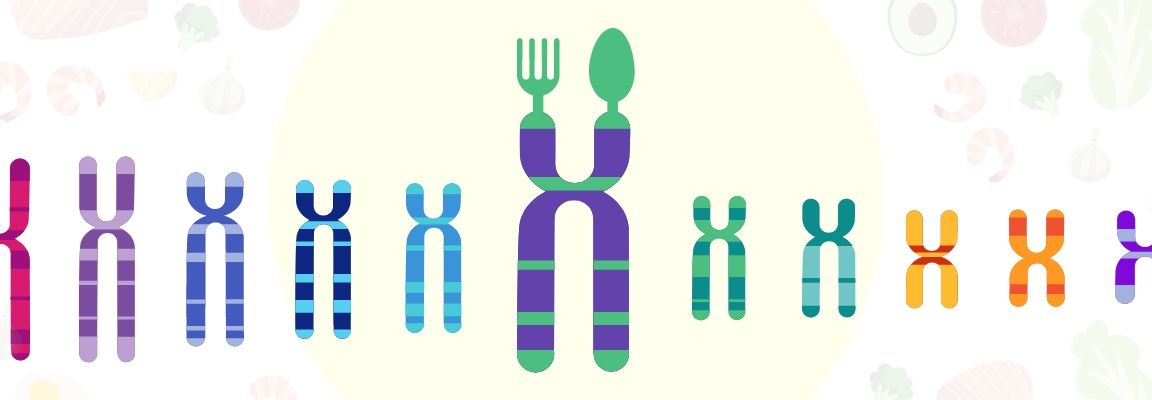The nutritional status of a person is the result of the interaction between health, nutrition and genetics. The study of this relationship is addressed by nutritional genetics or nutrigenetics, which aims to study how DNA influences nutrition and to be able to apply this knowledge to individualize each person’s eating plan based on his or her DNA, in order to improve his or her health.
Nutrigenetic tests, such as the ones we do at tellmeGen, can provide very useful information on aspects related to nutrition and health, with the aim of providing personalized tools to take care of ourselves and try to improve our quality of life.
tellmeGen DNA test includes genetic information for various characteristics related to nutrition, metabolism or some intolerances. All of them are complex traits whose result is the result of a combination of genetic and environmental factors that contribute to a greater or lesser degree. With the help of genetic tests we can learn more about how DNA influences a certain trait and thus change our lifestyle habits to get the best result.
To provide the results, at tellmeGen we use the latest scientific information published in genetic databases, as well as powerful bioinformatics algorithms that allow us to provide the most accurate result possible.
In most cases, genetic loci that have been associated with the development of a complex trait are analyzed by different scientific projects following the GWAS methodology. In these projects, thousands of individuals who present a certain condition (cases) are compared with thousands of individuals who do not present it (controls) and we identify which genetic variants have an impact on the development of a certain condition. At tellmeGen we use different methods to estimate the result of your combination and provide a probability result based on your genetics.

Below, we will explain some of the results we provide in our nutrigenetic analysis to give you the opportunity to adapt your lifestyle according to your genetics. However, remember that if you have doubts or want a much deeper interpretation, you have at your disposal a group of experts in nutrigenetics that will help you to elaborate a nutritional plan according to your results and will provide you with much more useful information that you can use in your daily life.
tellmeGen’s DNA tests include a great amount of information related to nutrition, from the analysis of the risk of presenting deficiencies of certain compounds such as vitamins, cholesterol, etc., to the predisposition to certain intolerances such as lactose or celiac disease, or the basal metabolic rate. Vitamins, among other nutrients, are one of the most important elements of our nutrition and well-being.
Many food intolerances and allergies are genetic and can be detected through DNA analysis. If you’re wondering, yes, allergies are hereditary.
Vitamin A
Vitamin A includes several fat-soluble substances such as retinol and beta-carotene. It is important for proper growth and development, maintenance of the immune system, cell differentiation and proper vision. It also plays an important role in aging and in the development of certain diseases.
What foods are rich in vitamin A?
Vitamin A can be found in foods in two main forms: retinol and some carotenoid derivatives. These compounds are widely distributed in foodstuffs, the most important of which are:
- cod liver oil
- turkey liver
- pork
- chicken
- sweet potato
- carrot
- broccoli
- dairy products
Vitamin B12
Vitamin B12, also called cobalamin, is a vitamin of bacterial origin essential for the proper functioning of the nervous system, and in essential processes such as DNA synthesis.
Vitamin B12 deficiency can occur for various reasons such as restrictive diet (relatively common in vegetarians or vegans), gastric disorders or defects in its metabolism.
What foods are rich in vitamin B12?
Vitamin B12 is found in foods of animal origin, including:
- fish
- seafood
But especially in:
- meat
- eggs
- milk and dairy products
It has also been found to be present in some plant-derived fermented products such as kombucha tea.
Vitamin B12 is also added as a supplement in many processed foods and is also available in multivitamin supplements. Some companies advertise certain compounds, such as spirulina and certain algae, as a source of vitamin B12 although their use is controversial because they do not possess the biologically active metabolite of the vitamin.
Vitamin D
Vitamin D is a fundamental nutrient for the maintenance of our health. Its main function is the regulation of calcium and phosphate levels, so it has a nutritional role in the maintenance of healthy bones and teeth. It is also involved in the functioning of the nervous, immune and muscular systems.
What foods are rich in Vitamin D?
Vitamin D is mainly produced in the skin with sun exposure. The action of UV rays transforms 7-dehydrocholesterol into vitamin D3, an inactive precursor that must be metabolized in the liver and kidney to be functional. We can also find the source of vitamin D in the diet, mainly in products such as:
- oily fish
- avocado
- tofu
- eggs
- mushrooms
- milk
- beef
- chicken
Omega 3
Omega-3 is an essential polyunsaturated fatty acid involved in the regulation of the inflammatory process. It is also involved in numerous cellular functions such as cell membrane signaling and fluidity, nervous system regulation, blood pressure, blood coagulation and glucose tolerance.
Among the long-chain polyunsaturated fatty acids, omega-6 is also found, with some opposite functions to omega-3, such as its pro-inflammatory activity. Moreover, although they are involved in important biological functions, their excess has been associated with an increased risk of cardiovascular and neurological diseases.
Currently, recommendations to replace the intake of foods rich in saturated fats with those rich in polyunsaturated fatty acids have led to an increase in the consumption of omega-6, which translates into a lower bioavailability of omega-3, which, if not compensated by intake, can have an impact on our health.
What foods are rich in omega-3 fatty acids?
They are healthy fats that our body is not able to manufacture on its own, so they must be incorporated through the diet. Among the foods that contain these compounds, the following stand out:
- blue fish
- certain seafood
And some vegetable sources such as:
- soybean oil
- flaxseed oil
- walnuts
Cholesterol
Cholesterol is an essential lipid for the proper functioning of the body. It is found in the cell membranes of all body tissues and in the blood.
It is a water-insoluble molecule that must be transported in the blood in the form of macromolecular complexes called lipoproteins. The best known are HDL, or high-density lipoprotein, and LDL, or low-density lipoprotein.
HDL, commonly known as “good cholesterol“, is responsible for transporting free cholesterol from the tissues to the liver for elimination. It is associated with a lower risk of vascular accident.
On the other hand, LDL transports free cholesterol to the cell that needs it. The latter is commonly known as “bad cholesterol” because of its known role in the process of atherosclerosis, in which excess plasma LDL is deposited on the walls of the arteries, significantly increasing the risk of vascular accidents.
In general, the consumption of foods rich in polyunsaturated fats that favor the synthesis of HDL to the detriment of LDL is recommended. These foods include:
- oily fish
- nuts
- avocado
- olive oil
In addition, it is recommended to limit the consumption of foods rich in saturated fats such as processed animal products, sugary and ultra-processed products, among many others.
Lactose intolerance
Predisposition to lactose intolerance is another of the items we analyze in our nutrigenetic test.
Lactose is the main sugar present in milk. Humans cannot directly use this compound as a source of energy and need the action of lactase for this purpose. On some occasions, this lactose cannot be metabolized due to a deficient production of lactase and certain associated symptoms such as abdominal bloating, diarrhea or abdominal pain occur.
In case of diagnosed lactose intolerance, it is recommended to avoid lactose-containing foods.
Lactase is encoded by the LCT gene in which genetic variants associated with a lower expression and, therefore, a decrease in the expression of lactase have been identified. Carriers of these variants show a lower production of the enzyme responsible for lactose degradation and are more prone to the development of intolerance. However, the decrease in lactase production is progressive over time when you are a carrier, so you can be at risk of lactose intolerance and still continue to produce enough.
Predisposition to celiac disease
Celiac disease is a disorder of autoimmune origin caused by a permanent intolerance to gluten, which develops in genetically predisposed individuals. The only treatment available is a strict gluten-free diet that must be maintained for life.
Genetic predisposition to celiac disease is mainly determined by the presence of HLA-DQ2.5 and HLA-DQ8 haplotypes, which are found on the surfaces of some cells and respond to the presence of gluten, activating the inflammatory response. Thus, patients with celiac disease have at least one copy of any of these haplotypes. The absence of these haplotypes leads to the suspicion that the person does not have celiac disease. Because of all this, celiac disease is hereditary.
With tellmeGen’s nutrigenetic test you can find out if you have any of these haplotypes and if you are therefore predisposed to develop this condition.
MTHFR gene
The MTHFR gene encodes for a key protein in folate metabolism. It is responsible for transforming folic acid ingested in the diet into a form usable by the body. In addition, it also converts homocysteine into methionine, an essential amino acid.
Several studies have associated the presence of some common genetic variants in the population, specifically C677T and A1298C, with decreased folate metabolic capacity. This can lead to a decrease in blood folate levels and an increase in homocysteine levels, which has been associated with an increased predisposition to various conditions such as coronary artery disease, thrombophilias and fertility problems, among others.
Therefore, genetic evaluation of the presence of these two variants can give us information about our ability to metabolize folic acid and homocysteine.
A team of experts in nutrigenetics is always at your disposal
In the DNA test results, you will receive valuable information about your genetic predisposition to have increased or decreased levels of the vitamins and metabolites analyzed, such as those mentioned above, as well as your susceptibility to certain intolerances such as lactose or gluten. In many cases, this information can be a good approximation for estimating blood or tissue levels of these compounds, which can help us to know whether or not, and if so how, to modify our eating habits and/or lifestyle.
After receiving your results, we provide you with our nutrigenetics experts who will be able to evaluate your results in depth, help you understand your results as well as possible and give you the most appropriate dietary and lifestyle recommendations to improve your nutritional and health status.




